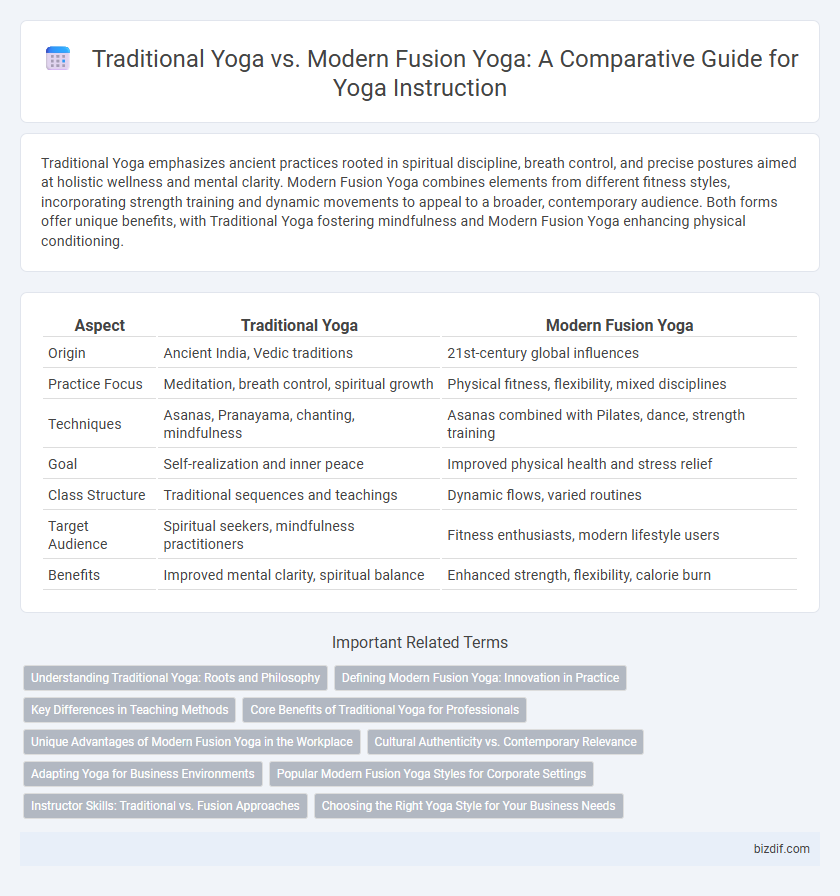Traditional Yoga emphasizes ancient practices rooted in spiritual discipline, breath control, and precise postures aimed at holistic wellness and mental clarity. Modern Fusion Yoga combines elements from different fitness styles, incorporating strength training and dynamic movements to appeal to a broader, contemporary audience. Both forms offer unique benefits, with Traditional Yoga fostering mindfulness and Modern Fusion Yoga enhancing physical conditioning.
Table of Comparison
| Aspect | Traditional Yoga | Modern Fusion Yoga |
|---|---|---|
| Origin | Ancient India, Vedic traditions | 21st-century global influences |
| Practice Focus | Meditation, breath control, spiritual growth | Physical fitness, flexibility, mixed disciplines |
| Techniques | Asanas, Pranayama, chanting, mindfulness | Asanas combined with Pilates, dance, strength training |
| Goal | Self-realization and inner peace | Improved physical health and stress relief |
| Class Structure | Traditional sequences and teachings | Dynamic flows, varied routines |
| Target Audience | Spiritual seekers, mindfulness practitioners | Fitness enthusiasts, modern lifestyle users |
| Benefits | Improved mental clarity, spiritual balance | Enhanced strength, flexibility, calorie burn |
Understanding Traditional Yoga: Roots and Philosophy
Traditional Yoga originates from ancient Indian philosophy rooted in the Yoga Sutras of Patanjali, emphasizing the Eight Limbs of Yoga, including ethical principles, meditation, and physical postures (asanas) as a path to spiritual enlightenment. It focuses on holistic integration of mind, body, and spirit, promoting self-discipline, mindfulness, and inner awareness through practices like pranayama (breath control) and dhyana (meditation). Understanding these foundational elements provides deeper insight into the authentic purpose of yoga beyond physical fitness, distinguishing it from the more eclectic and fitness-driven approach of Modern Fusion Yoga.
Defining Modern Fusion Yoga: Innovation in Practice
Modern Fusion Yoga integrates traditional postures with contemporary fitness techniques, creating dynamic sequences that enhance strength, flexibility, and mindfulness. This innovative practice incorporates elements from Pilates, dance, and high-intensity interval training (HIIT), appealing to diverse fitness levels and preferences. Emphasizing adaptability, Modern Fusion Yoga redefines conventional methods by blending ancient wisdom with modern exercise science for holistic well-being.
Key Differences in Teaching Methods
Traditional Yoga emphasizes a structured approach rooted in ancient texts like the Yoga Sutras, focusing on alignment, breath control (pranayama), and meditation to cultivate mindfulness and spiritual growth. Modern Fusion Yoga integrates elements from diverse fitness disciplines such as Pilates, dance, and strength training, offering dynamic sequences aimed at physical conditioning and flexibility. Instructors of Traditional Yoga prioritize lineage-based techniques and subtle energy work, whereas Fusion Yoga teachers emphasize innovation, adaptability, and a fitness-oriented experience.
Core Benefits of Traditional Yoga for Professionals
Traditional Yoga emphasizes deep breathing, mindfulness, and consistent postures that enhance mental clarity and reduce workplace stress. Professionals benefit from improved concentration, increased flexibility, and balanced energy levels achieved through authentic practices like Ashtanga or Hatha Yoga. This time-tested method also supports holistic wellness by integrating physical, mental, and spiritual health, fostering long-term resilience and productivity.
Unique Advantages of Modern Fusion Yoga in the Workplace
Modern Fusion Yoga integrates dynamic movements and mindfulness techniques tailored for workplace stress relief and improved productivity. This approach combines traditional poses with contemporary fitness elements, promoting enhanced flexibility, mental clarity, and energy levels during office hours. Employers report increased employee well-being and focus, making Modern Fusion Yoga a practical, effective wellness solution in corporate environments.
Cultural Authenticity vs. Contemporary Relevance
Traditional Yoga preserves ancient practices rooted in Indian philosophy, emphasizing authentic breathwork, meditation, and classic asanas that foster spiritual growth and holistic well-being. Modern Fusion Yoga incorporates elements from various fitness styles and global influences, appealing to contemporary lifestyles with dynamic sequences and accessible modifications. Balancing cultural authenticity with contemporary relevance requires respecting yoga's origins while adapting to diverse practitioners' needs and evolving wellness trends.
Adapting Yoga for Business Environments
Traditional Yoga emphasizes deep-rooted practices such as breath control, meditation, and alignment, catering to holistic well-being and mental clarity. Modern Fusion Yoga integrates diverse movement styles and contemporary fitness techniques, making it more accessible and engaging for busy professionals. Adapting Yoga for business environments involves creating short, focused sessions that reduce stress, enhance productivity, and promote workplace wellness through tailored practices.
Popular Modern Fusion Yoga Styles for Corporate Settings
Modern fusion yoga styles popular in corporate settings include Vinyasa Flow, which emphasizes dynamic sequences that improve flexibility and reduce stress; Power Yoga, designed to build strength and increase energy levels; and Restorative Yoga, focusing on relaxation and mindfulness to combat workplace burnout. These styles integrate traditional asanas with contemporary fitness and wellness trends to enhance mental clarity and productivity. Corporations often choose these adaptable formats to promote employee well-being and foster a balanced work environment.
Instructor Skills: Traditional vs. Fusion Approaches
Traditional yoga instructors emphasize deep knowledge of classical postures, breathing techniques, and Ayurvedic principles, fostering mindful alignment and spiritual growth. Fusion yoga teachers blend multiple styles, requiring versatility in movement patterns, music integration, and adaptive sequencing to cater to diverse student needs. Mastery in either approach demands a comprehensive understanding of anatomy, pedagogy, and the ability to create safe, effective yoga experiences.
Choosing the Right Yoga Style for Your Business Needs
Traditional Yoga emphasizes ancient techniques promoting holistic wellness, spiritual growth, and deep mindfulness rooted in centuries-old practices such as Hatha and Ashtanga. Modern Fusion Yoga integrates contemporary fitness trends, dynamic sequencing, and cross-disciplinary elements designed to attract diverse clientele seeking variety and physical challenge. Selecting the right yoga style depends on your target market, business goals, and desired brand identity, ensuring alignment with either authentic tradition or innovative appeal to maximize customer engagement and retention.
Traditional Yoga vs Modern Fusion Yoga Infographic

 bizdif.com
bizdif.com